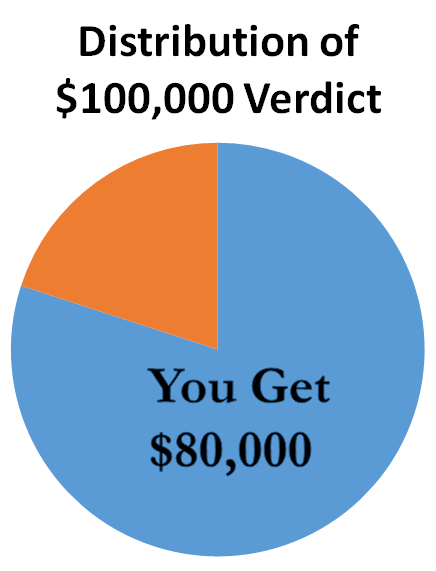Article Updated: August 3, 2021
How to Determine if
You Have a Personal Injury Case
If you were involved in an auto accident, you may be wondering, do I have a personal injury case?
This is in reality two questions, which are as follows:
♦ Do I have a personal injury case that is viable?
♦ Do I have a personal injury case worth pursuing?
You need a “yes” answer to both questions. If the answer is “no” to either question, you either do not have a personal injury case or no lawyer will take your case. Very rarely are both answers “no.”
One study showed that over 26% percent of people did not file a lawsuit because they thought their injuries were not serious enough. At Injury Advocates Group, our lawyers have encountered many of that 26% first hand.
We often speak with potential clients who shyly ask if their case is serious enough to pursue. 98% of the time the answer is yes. You may not have a $1,000,000 case. You may only have a $10,000 case. That is still a claim worth pursuing, especially when a lawyer handles the headache for you while you move on with your life.
With that in mind, this article will start by addressing the first question – whether the facts of your accident satisfy the legal threshold to be a personal injury claim.
Do I Have a Legally Viable Personal Injury Case?
You have a viable personal injury case if you satisfy four legal elements. Those elements are:
♦ Duty
♦ Breach of duty
♦ Causation
♦ Damages
There is a formal text which describes each of these elements. It is the book from which a judge explains to the jury how to decide a case. We have a copy of that book, and refer to it frequently. It is the Judicial Council of California’s Civil Jury Instructions. The explanations in that text are, as you might expect, fairly wordy. It is condensed and synthesized for you below into simple, non-lawyer language.
Elements 1 and 2: Duty & Breach
These two element are often referred to as negligence. Here is a simple example:
♦ Drivers have to stop at stop signs
♦ A driver ran a stop sign and hit you
From that, we have “duty” (do not run stop signs) and “breach of duty” (driver ran a stop sign).
That is negligence. In non-legal talk, it means another driver did something wrong.
But what if you also did something wrong? For example, consider a situation where you did a rolling stop through a stop sign, but another driver was driving drunk and blew through the stop sign going 2x the speed limit and did not slow or stop at all before hitting your car. What happens in those situations?
California follows a rule called “pure comparative negligence.” California courts adopted this rule in 1975, in the landmark case of Li v. Yellow Cab Co., 13 Cal. 3d 804 (1975). Under a pure comparative negligence law, two vehicles involved in an accident are each liable for the percent of fault which they contributed to the accident happening.
A visual might help, using the example I introduced above about the stop sign. If in that example, the result at trial was this:
♦ Jury awards a $100,000 verdict
♦ Jury finds you are 20% at fault for your rolling stop
♦ Jury finds the drunk driver is 80% at fault for speeding, blowing the stop sign, and speeding
The result would look like this:
Because the jury found you to be 20% at fault, you cannot recover 20% of the verdict, which is $20,000 of the $100,000 verdict. With a verdict this process is somewhat easy, in the sense that the jury tells you definitively what percentage you will get. What about a settlement?
In a settlement, a lawyer has to advocate to the insurance adjuster and explain why the value of your case is not compromised, or why it is only compromised a little bit. There is no formula for this. It requires skilled advocacy, and experience in calculating how much a case is worth.
Elements 3: Causation
If, as a result of a driver running a stop sign and t-boning you, you suffer a herniated disc in your neck that you did not have before the accident, you have “causation.” Causation means that the other driver’s negligence “caused” something bad to happen to you.
This seems obvious, but it is not. For example, consider a situation where you were in a car accident last week and injured your neck. Then, yesterday you were struck when a car blew through a stop sign, hurting your neck even more. How much, if any, of your neck pain is being “caused” by this second accident?
Causation can get tricky. If your lawyer is not savvy with medical literature and the science behind and supporting your specific injury, you might be in trouble.
Our lawyers have received calls in the past from clients who were in the above scenario of two accidents within a few weeks apart from each other. Other lawyers had rejected the case. Our lawyers took a deeper look, and found ways to distinguish the injuries from the first and second accident. By doing that, we developed a path to proving this third element of “causation” and allowing the client to have a viable personal injury claim.
Element 4: Damages
Not everyone who is involved in a car accident is injured. Not every injury is compensable. You must suffer a legally compensable injury, or set of “damages,” to have a viable personal injury case. The most common compensable damages are:
♦ Medical expenses
♦ Lost wages
♦ Non-economic damages (pain, suffering, inconvenience, and mental anguish)
For every damage or loss that you claim you suffered because of the car accident, you must prove the third element of “causation.”
An example illustrates this point.
♦ After being t-boned in an intersection, John takes 2 weeks off from work
♦ John get paid $1,000 a week, so he has $2,000 of lost wages
♦ John could have returned to work after 1 week
♦ John took that extra, 2nd week off from work to relax and play video games
If John’s doctor does not believe John needed to take that 2nd week off from work, then that 2nd week and related $1,000 in lost wages were not “caused” by the accident, and are not recoverable as part of John’s lawsuit against the driver that caused his accident.
This is prime area of attack for insurance companies and adjusters. They will closely examine the relationship (i.e., the causal nexus) between each dollar of damages you ask for in your settlement and whether your specific damages were caused a specific injury, and whether each specific injury was caused by the accident.
If an adjuster is getting you lost in the weeds or giving you a lowball offer with this insurance strategy, call our office for help. It is, however, much better to call an attorney before that happens. Once you make statements to the adjuster and take positions on facts related to causation and damages, it becomes very difficult to undo the harm done to your case.
Do I Have a Personal Injury Case Worth Pursuing?
In our experience, over 98% of the time the answer is yes. Because of that, it is easier to answer this question by explaining the situations where you do not have a case, rather than outline the many situations where you would have a case.
You would not have a personal injury case worth pursuing if your anticipated recovery is so small that it is not enough to make you money after attorneys’ fees, case costs, and medical liens or subrogation rights are deducted.
Generally, those are situations where you have less than three doctor visits. For example, after an accident you go to the ER, then to your family doctor, then one time to an orthopedic doctor who told you nothing is wrong and you do not need any further medical care. After that, you do not see any more doctors or receive any other medical treatment. Your medical bills might be around $1,500. Your settlement might look like this:
♦ $1,800 personal injury settlement
♦ $600 in attorneys’ fees
♦ $200 in case expenses
♦ $800 medical or health insurance lien or subrogation claim
That results in $200 of net money in your pocket. You get to decide, do you think you have a personal injury case worth pursuing if your take home net is $200? If yes, call a lawyer.
Keep in mind that the above numbers are for demonstrative purposes only. Those 3 doctor visits can total $7,000 or more depending on which hospital and orthopedic doctor you visit, and what diagnostic tests are done at each. Those same 3 doctor visits that net you $200 under one set of facts, can net you $4,500 under another set of facts. There is a lot of volatility here, which is why you should speak with a lawyer.
Los Angeles Area Personal Injury lawyer
If you are trying to find out if you have a personal injury case or, more importantly, one worth pursuing, the best thing to do is call a lawyer. You could read a lot of online articles that help you hazard a guess. However, if you guess wrong you could miss out on a $5,000 or larger settlement check for a claim you thought was only worth a few hundred dollars.
To learn more, and speak with a lawyer at our firm for a free consultation, call (800) 484-0779, email us at info@injuryag.com, or fill out the contact form below.
Injury Advocates Group lawyers have recovered over $10,000,000 for personal injury clients. We are a no recovery no fee law firm. Our success is tied directly to your success. No matter the size of your case, we will fight to get you the largest recovery possible.

About the Author
Article Author: This law article was written by attorney Ray Benyamin, Esquire. Mr. Benyamin received his Juris Doctor degree from the Thomas Jefferson School of Law, and his license to practice law from the State Bar of California. His law license number is 277263. He has been practicing law for 10 years. Mr. Benyamin is a registered member of the following legal organizations: Consumer Attorneys Association of Los Angeles (CAALA), the Los Angeles County Bar Association (LACBA), the State Bar of California, the American Bar Association (ABA), and the American Association for Justice (AAJ). Mr. Benyamin has personally helped his clients recover over $10,000,000 dollars in vehicle accident insurance claims in the State of California.
Our Lawyers Serve Clients in Los Angeles, California & Nationally
Serving all of Los Angeles, including Arcadia, Beverly Hills, Claremont, Canoga Park, Chino, Chino Hills, Covina, Diamond Bar, Downey, East Pasadena, El Monte, Encino, Highland Park, Inglewood, La Verne, Long Beach, Malibu, Montebello, Monterey Park, North Hollywood, Northridge, Pasadena, Pomona, Rancho Cucamonga, Reseda, Rosemead, San Gabriel, San Dimas, Santa Monica, Sherman Oaks, South Bay, South LA, South Pasadena, Sunland, Tarzana, Thousand Oaks, Torrance, Van Nuys, Venice, West Covina, West Hollywood, and Westlake Village.
Serving all of California, with a focus on Kern County, Los Angeles County, Orange County, Riverside County, San Bernardino County, San Diego County, Santa Barbara County, and Ventura County.
Serving nationwide in all 50 states on a case-by-case basis with a national network of relationships and on a Pro Hac Vice basis.


